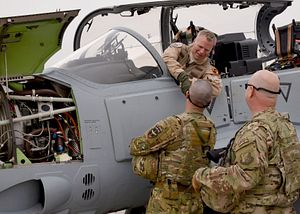Four additional Embraer/Sierra Nevada Corporation A-29 Super Tucano light attack aircraft slated for service in the Afghan Air Force (AAF) arrived at Hamid Karzai International Airport on March 20, according to a March 20 U.S. Air Force (USAF) statement.
This brings the total number of A-29s currently in service with the AAF up from eight to 12 aircraft. Following a brief reconfiguration, the aircraft will be ready for service for the 2017 fighting season, which traditionally kicks off in spring, although the last two years saw little slowdown of fighting over the winter months.
“The four additional aircraft will allow us to increase the number of missions we are able to support nationwide,” said an AAF A-29 pilot. “More targets can be attacked—more ground troops can be supported.” According to a February 2017 Military Times investigation, Afghan pilots operating the A-29 and the Md-530 Cayuse light attack helicopter — the AAF’s other close-air support aircraft — have been more trigger happy than their coalition counterparts in 2016.
”Afghanistan’s primary attack pilots are firing their weapons during four of every 10 combat missions, a rate more than three times greater than that of their U.S. Air Force counterparts,” the Military Times investigation found. “In 2016, Afghan pilots operating their country’s two primary attack aircraft — the fixed-wing A-29 Super Tucano and the MD-530 Cayuse Warrior, a small but potent attack helicopter — flew 1,992 sorties and conducted 800 airstrikes.”
A senior U.S. officer quoted in the USAF press release said that the A-29 aircraft were a “game changer” during the 2016 fighting season and that he harbors great expectations of the A-29 and the AAF in 2017. “The AAF pilots are continually gaining proficiency in the A-29,” Brigadier General David Hicks said. “They are capable of providing air attack anywhere in the country. In the past, the Afghan National Army relied on the coalition for air support. Now, it’s their own countrymen overhead flying the missions.”
Recent reversals on the battlefield including the apparent capture of the strategic district of Sangin in Afghanistan’s southern province of Helmand by insurgent forces on March 23, however, do not bode well for the general’s optimism, and what I argued at the beginning of last year’s fighting season continues to hold true for 2017 (See: “Afghanistan: Will the Afghan Air Force Make A Difference in the 2016 Fighting Season?”):
What will determine the impact of the new aircraft more than anything else, however, is how the A-29 will be used during the 2016 fighting season by senior Afghan military leadership, since this will have an direct impact on the military culture of the ANA for the years to come. (…)
Overall, the induction of the A-29 light attack aircraft will bring the ANDSF a step closer to becoming a more professional fighting force. However, we should not expect that the new planes will be able to reverse overall battlefield failures and the aircraft will certainly not be capable of guaranteeing battlefield successes on its own.
The USAF spent a total of $427 million under its so-called Light Air Support program to supply the AAF with 20 A-29 aircraft by the end of 2018. As I reported elsewhere (See: “Confirmed: First Four A-29 Light Attack Aircraft Arrive in Afghanistan”):
Brazilian aircraft maker Embraer and its U.S. partner Sierra Nevada Corporation where initially awarded the contract to supply 20 A-29 light attack aircraft in 2011. However, the contract was cancelled in 2012 due to a dissatisfaction of USAF leadership “with the quality of the documentation supporting the award decision.” However, the contract was re-awarded to Embraer and Sierra Nevada Corporation in 2013.
“In hindsight, I wish we would’ve started that years ago,” the commander of U.S. Forces in Afghanistan, General John F. Campbell said in front of the U.S. House of Representatives Armed Services Committee in March 2015, yet “we are where we are. (…) Quite frankly, we can’t get it out there quick enough for them.”
The aircraft can be fitted with up to two 500-pound (226 kilogram) conventional or smart freefall bombs, in addition to short-range air-to-air missiles, machine guns and rockets. However, it is still unclear whether the AAF’s A-29s have the capability for surgical airstrikes. The aircraft has been specifically designed for counterinsurgency campaigns, and is relatively cheap to operate (one hour of flying time costs around $1,000).































